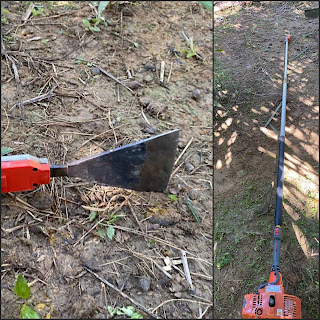FPA150 REPORT: FIELDWORK II
WEEK 7 (24 NOVEMBER 2023)
WEED, PEST AND DISEASE CONTROL IN NURSERY
VENUE: NURSERY PLOT
SUBMISSION DATE: 29 NOVEMBER 2023
Hi assalamualaikum dear readers. I would like to be thank to all of you for always check out on my page and read my fieldwork journey. I hope you have an amazing mid semester break and in a good condition. In this blog, I will share with you about what I have learnt since week 7 until week 9. It was wonderful class session with a practicle to do along with my classmate!
There are a lot of knowledge that I have gained regarding weed, pest and disease control in nursery. Before I continue, do you know what is weed, pest and disease?
Weeds are unwanted plants that compete for resources with crops in agriculture. Pests are organisms that harm or destroy crops, such as insects or rodents. In the context of agriculture, "disease" refers to illnesses that impact plants and are brought on by pathogens such as bacteria, fungi, or viruses. Effective management of these variables is essential for productive crop cultivation.
What will happen if you do not cure them from the start?
- Firstly it will reduced crop yield. Crops may experience a decrease in yield as a result of competition from weeds, pests, and diseases for vital resources like sunlight, water, and nutrients.
- Next, it will result in higher production costs. By adding pesticides, herbicides, and fungicides to the mix is often necessary to control diseases, weeds, and pests. Farmers' costs of production may rise dramatically as a result.
- In addition, the utilization of chemical control techniques for the management of weeds, pests, and diseases may result in adverse environmental consequences, including contamination of water and soil. Furthermore, it could damage organisms that are not its intended target, reducing biodiversity in agricultural ecosystems.
To prevent those thing from happen, there are a few ways you can do. For instance, using herbicides, which are substances created expressly to destroy or stop the growth of weeds, is known as chemical weed control. Both selective and non-selective herbicides can destroy a wide variety of plant species. Selective herbicides target particular kinds of weeds. Among them are 2,4-D and glyphosate. Without the use of chemicals, mechanical weed control entails physically pulling or destroying weeds. Manual weeding, hoeing, plowing, and mowing are examples of mechanical methods. These methods stop weeds from growing and taking resources away from crops.
WEEK 8 (1 DECEMBER 2023)
PROPAGATION TECHNIQUES
VENUE: NURSERY PLOT
SUBMISSION DATE: 6 DECEMBER 2023
On the 8th week, I started my day with Fajr prayer together with Part 1,2 and 3 at Surau At Taqwa. After finish with assembly at Agrotech, all of students of part 2 gathered at nursery plot to learn about propagation.
- Seeds: Plants are propagated by seeds, which are genetically derived from both parent plants.
- Grafting: The process of growing a new plant by joining a stem or bud (scion) from one plant to the rootstock of another.
- Layering: allowing a stem to split off from its parent plant after roots have begun to form on it in order to produce a new plant.
- Division: The process of dividing an established plant into sections, each with its own roots and shoots.
- Tissue culture, also known as micropropagation, is the process of growing plants in a controlled laboratory setting using small amounts of plant tissue. These methods offer flexibility and are chosen based on factors like plant species, goals of propagation, and environmental conditions.
WEEK 9 (8 DECEMBER 2023)
ROOT PRUNING AND TRANSPLANTING THE YOUNG SEEDLING
VENUE: LADANG KELAPA SAWIT
SUBMISSION DATE: 13 DECEMBER 2023
Assalamualaikum everyone. Hello and welcome, dear readers! Delighted to have you join us in this digital space where ideas flourish and conversations thrive. Gratitude fills my words as I express heartfelt thanks to each of you for continuing this journey with me. Your unwavering support and engagement make this shared adventure all the more meaningful. Here's to the chapters we've explored and those yet to unfold!
On this week, we have learned about harvesting and practiced at Ladang Kelapa Sawit UiTM Jasin. Here are some photos that my friends took.


























No comments:
Post a Comment